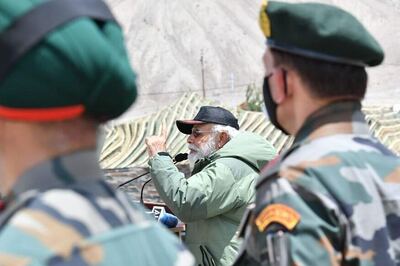
views
There was once a time, long before the unpopular term ‘Urban Naxalism’ was floated, when one young man who devoted himself to the cause of nationalism, working for the weakest sections of our nation, was rewarded with a similar sobriquet. He was called India’s first ‘Urban Terrorist’ and his name was Ram Narayan Kumar.
Kumar belonged to a South Indian Brahmin family and lived with his father, who was a priest in a monastery in Ayodhya. But he left the monastery in 1975 and was sent to a jail at the age of 19 for opposing the Emergency. Since the age of 19 till he died at the ripe age of 53 he spent his life fighting for the workers, farmers, tribals, Dalits, religious minorities and the destitute.
While in Tihar jail, he fought for the rights of prisoners. Soon after being released he began working for Sikhs, many of who were being killed in fake encounters during the peak of Khalistani militancy. He collected evidences of innocence of some of the people who were wrongly declared as terrorists and killed by the Punjab police. There is a long list of struggles that he undertook to keep democracy intact. His story of being branded as the first “Urban Terrorist” of country is quite unusual.
Disturbed by the plight of the workers of the coal mines in Madhya Pradesh, Ram Narayan Kumar took them along and reached straight away the residence of Member of Parliament Dalbir Singh in Delhi and laid a siege there for nine long hours on April 13, 1982. At that time, a variety of allegations were levelled against him by various newspapers. While some news reports called him an Urban Terrorist, the US dubbed him as an agent of KGB. And for many others, he remained an agent on US rolls.
Just as terrorism was earlier branded into urban and rural phenomena, Naxalism too has been segregated into urban and rural regions. In the same way that police have ‘arrested innocent, educated and economically sound Muslim youths by drawing fictitious links between them and acts of terrorism’, efforts have been made with the help of media to carry out something similar in case of ‘Urban Naxals’. Through these arrests, efforts have been made to contain the anger of Dalits against the present regime, and in this, manufactured theory of ‘Urban Naxalism ‘is an effective tool.
In simultaneous raids on August 28, lawyers, journalists and educationists who have been arrested from Delhi, Goa, Mumbai, Hyderabad, Thane and Ranchi etc. have all been branded ‘Urban Naxals’. Particularly vicious has been the propaganda against Sudha Bhardwaj.
Jingoistic media channels have deliberately suppressed the fact that she belongs to a renowned educationist family and has devoted her entire life in fighting for the rights of tribals. She is a well-known lawyer who renounced her US citizenship when thousands of our “patriots” are hankering for US citizenship.
Gautam Navlakha, former editor of Economic & Political Weekly, is a famous human rights activist. He has been involved in fighting against the draconian Prevention of Terrorism Act (POTA)and UAPA. Varavara Rao is a retired professor and renowned poet in Telugu. And Anand Teltumbde, who comes from Dr. Bhim Rao Ambedkar’s family, is known for his sharp intellect all over the world. Arun Ferreira is a dedicated lawyer and has been associated with various Dalit movements. He was arrested earlier also for his alleged links with Maoists, but the court acquitted him. Vernon Gonsalves was a professor in a famous college in Mumbai.
But by no means are they the only people to have been punished in this way. Before them, on May 6, 2018, a famous lawyer from Nagpur Surendra Gadling, head of the department in the English Department of Nagpur University, Prof Shoma Sen, famous Marathi poet, editor Sudhir Dhawle, Roma Wilson who was active in the campaign of release of political prisoners, and “Prime Minister Fellowship” holder Mahesh Raut were arrested. Surendra Gadling is famous for fighting for Dalits and tribals.
Interestingly, all these arrests are related to an incident of violence against Dalits on January 1 this year in Bhima Koregaon. Dalits had assembled there in large numbers on December 31, 2017 and an FIR was lodged against the right-wing elements responsible for violence. Instead of acting on that FIR, the police, on January 8, lodged another FIR by those who were responsible for violence, which stated that Dalits were instigated for violence in the meeting of Elgar Parishad that was convened on December 31, 2017 to commemorate 200 years of victory of Mahar Regiment.
How it was linked to Naxal connection
In March 2018, Pune Police converted the FIR of January 8 into a full-fledged theory alleging threat to internal security and was successful in establishing the incident of atrocities on Dalits as an incident of ‘Urban Naxal’ connection. It was then linked to an alleged conspiracy of assassinating the Prime Minister. It is worth remarking here that in the last few years, dozens of people have been arrested for alleged conspiracies of killing of top leaders. But the courts rejected most of these allegations as fake.
The twin allegations of ‘Urban Naxalism’ and conspiracy of Prime Minister’s assassination have given police unlimited power. Using this very power, police conducted simultaneous early morning raids on August 28 in Delhi, Goa, Hyderabad, Ranchi, Thane and Mumbai at the residences of professors, lawyers, journalists, cultural and human rights, alleging their involvement in anti-national conspiracies.
Publicity first, arrests later
In recent years, a large section of police and sections of media have been actively complementing each other in discrediting human rights workers, professors, lawyers and branding them as internal security threats. The reasons behind this phenomenon become clear when we understand the nature of those being hounded.
Some of those on the crosshairs are lawyers, because they fight those fabricated cases with dedication in which people are sent to jails by the police on fictitious charges. There have been several incidents of attack and murder of those lawyers who dared to fight false cases of terrorism.
Teachers present a holistic viewpoint about the society before students. Students are targeted only because they have the strength to unite and rise against autocratic methods. We have also not surprisingly heard about the murders of several human rights activists in recent times.
While granting reprieve to five activists who were arrested on Tuesday under an anti-terror law on charges of Maoist activities, a Supreme Court judge remarked that “Dissent is the safety valve of democracy. If you don't allow the safety valve pressure cooker will burst.”
Pressure has been mounting, and off late to a bursting point. Even presuming that Supreme Court will step in to save the occasion as it earlier did many a times, such arrests are not likely to be the last of their kind. But those in power should know that enough pressure has built up. Time has come to either let some steam off or risk a destructive burst.
(The author is a senior journalist. The views expressed are personal.)




















Comments
0 comment